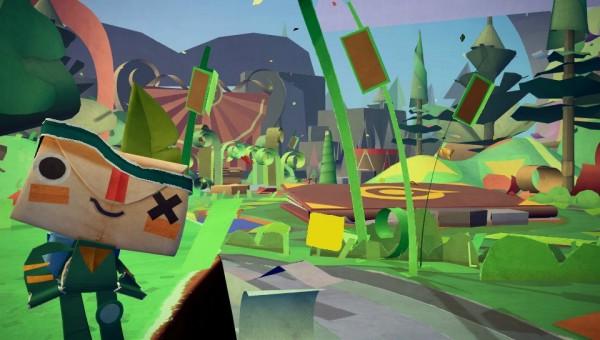
Media Molecule delivered a very different sort of game interwove into the 2D platforming fabric of LittleBigPlanet. The simplest synopsis is “user-generated content-driven platformer-slash-game engine,” though the underlying design supports a more base philosophy: play through creativity. It’s an approach that is now one step closer to becoming a proper studio identity for the UK-based developer thanks to Tearaway, an upcoming PlayStation Vita platformer built around the high-concept pitch of a “buddy” adventure that casts you, the player, in one of the two starring roles.
The story sees you guiding a papercraft avatar of your own design through an interactive origami world that you re-shape with pokes and prods at the Vita’s touch inputs. This turns out to be a product of the game’s story, which casts you in a dual role as both the benevolent provider of this folded paperscape and the driver of a messenger with an important delivery… for You. It all carries the flavor of self-reflective weirdness the Media Molecule excels at delivering, but through a more inwardly focused lens. If LittleBigPlanet is about delivering on your wildest dreams, Tearaway feels more like it’s tugging at the wonder of exploration and discovery.
“It’s obvious we have a history of platforming games, and Tearaway really is a platforming game at its heart.”
The narrower scope doesn’t come at the cost of creativity-focused interactions, however. The Vita’s touchscreen, rear touchpad, and two cameras are used extensively as you play. Sometimes it’s to solve platforming puzzles, or to snip out your own works of papercraft, or to snap a photo of your messenger with friend met along the way. These moments lend added personal flavor to an experience that plays like a relatively linear 3D adventure.
Media Molecule never allows you to forget that this is your world to explore, whether you’re poking your fingers through a flimsy bit of ground or catching glimpses of your face – captured in real time by the Vita’s front-mounted camera – as it looks down from the heart of the sun. It’s weird without being creepy, an innocent sort of playfulness that pairs well with the simple and intuitive mechanics.
“It’s obvious we have a history of platforming games, and Tearaway really is a platforming game at its heart,” Spafford says. “We’ve really pulled together our strengths to make that. But also, we find it very hard to do anything that isn’t craft-oriented. We love people being able to create things, to use the creative spirit that’s inside everyone and just kind of play with it a bit. So Tearaway has a whole bunch of customization.”

In place of the deeper customization tools of the studio’s earlier efforts is this inventive approach to story. In addition to buddying up with a virtual construct that you dress and customize as you like, you explore a narrative that draws inspiration from many of Europe’s lesser-known myths and legends. An early portion of the game that was recently demoed features a stroll through an elaborate floating garden that is home to a literal interpretation of the Green Man. The influence of European folklore scatters throughout Tearaway‘s story, though that wasn’t always the case.
“There was a point back in time when the world of Tearaway was just our world and you could go around to all of these different countries,” Spafford says. “But we didn’t want the countries to just be modern worlds, we wanted them to be like England or like France or whatever. And to do that you kind of have to pull on the tropes of those countries.”
“There are so many strange monsters that you can find throughout history that people will write about.”
This, too, ties into Media Molecule’s creation-driven vision. Drawing inspiration from myth is fundamentally open to interpretation, to artistic license. When you’re dealing with subjects that may or may not have actually existed, the impression of what those things are and what they look like changes according to the storyteller. This is something that Spafford says came up early on, as ideas were researched and fleshed out.
“We have a creature later on in the game called a Wendigo. And a Wendigo is a bit like a Bigfoot-y type monster,” he explains. “But if you Google ‘Wendigo’ and look at the images, there’s no one image that’s the same as another one. Everyone draws it completely differently.”
“When you’ve got something like that, it means that you can pull on the legend of the Wendigo, but you can make it look like whatever you want. It’s the same for a lot of the folktales and things like that. We can really take something, but we can have our own influence on it and it feels right for that to be happening.”


